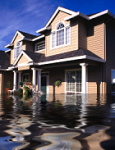
ASSE Offers Cleanup Tips for Flood-Related Mold
Mold grows easily in flood-related conditions, which include standing water, humid air, and wet surfaces, and the longer these conditions remain, as in the current flooding in the Midwest, the more the mold growth can spread. Addressing the issue, the American Society of Safety Engineers is offering tips to consider for those faced with cleaning up mold and minimizing its adverse effects, even while recognizing that individual circumstances are often unique and there is no one-size-fits-all solution.
"For businesses, addressing mold and moisture after a flood disaster should be the first step to reduce the risk to others who may need to work in an affected building," said ASSE Regional Vice President James H. Morris III. EPA recommends that "surfaces wet longer than 48 hours with 'clean water' should be considered as potentially contaminated, and any surfaces in contact with 'dirty water' should be considered contaminated." ASSE members recommend that people consult their state and local experts for more guidance regarding state and local laws and regulations addressing mold.
In addition, to lessen the chances of a mold colony growing in a store or business, CDC recommends that
- the humidity level be kept below 50 percent;
- an air conditioner or dehumidifier be used during humid months (depending on the climate);
- adequate ventilation, including exhaust fans, in the kitchen and bathrooms, be used;
- mold inhibitors be added to paints before applying them;
- bathrooms be cleaned with mold-killing products;
- carpeting in bathrooms, basements, or other areas where moisture or water could be a concern not be used.
Mold, ASSE members note, is a group of microscopic fungi, which also includes mildew and other organisms that rot materials on which they grow. Molds often can be invisible to the eye. A blotch of black, gray, white, red, orange, yellow, blue, or violet fuzzy or slimy growth is usually the result of widespread mold growth. Besides infection and allergic reactions, excessive mold growth indoors can result in offensive, musty odors from the gases released by certain molds as they grow and die.
"All mold cleanup operations individuals should wear proper personal protection equipment, which includes gloves, goggles and a respirator. However, the type of respirator varies on the size of the mold-affected area," said Morris, who is also the assistant director of School Plant Services, Environmental & Energy Management for the Virginia Beach City Public Schools.
ASSE offers the following tips for cleaning a facility/building affected by mold:
- Avoid direct contact with affected mold areas as much as possible.
- If it can be thrown away, throw it away. Replacements may be less expensive in the long term (and short term) than attempting to decontaminate some surfaces.
- If it cannot be disposed of, decontaminate and then dry as thoroughly as possible. Moisture removal is a key factor to preventing future growth.
- Wallboard can often be cut to the point of contamination and replaced with new sections.
- Clean all tools after use, or dispose if possible, and also clean tools after each shift.
- When in doubt about the structural integrity of a facility, obtain an evaluation by a licensed and qualified builder or structural engineer before entering. Medical clearance may also be necessary based upon the severity of mold in the area.
- Individuals involved in mold remediation should be aware that attempts to mix chemicals to clean surfaces can cause further damage, such as the toxic gases that can be released when ammonia and bleach are mixed. Workers need to exercise caution, so as not to create additional hazards. The power supply (circuit breakers) should be turned off in the specific damaged areas with high levels of moisture to avoid electrical shock hazards.
For ASSE's position statement on mold in the indoor working environment go to www.asse.org/professionalaffairs/govtaffairs/moldfinal0406.php. For more information and resources on mold safety and remediation visit EPA's Mold Resources Web page at www.epa.gov/mold/moldresources.html or download the OSHA Mold Fact Sheet at www.osha.gov/OshDoc/data_Hurricane_Facts/mold_fact..pdf. To obtain a draft of the ASSE/ANSI Z690, "Guidelines for Mold and Fungi Control and Remediation for Worker Protection in Indoor Work Environments," contact ASSE Customer Service at 847-699-2929, [email protected] or visit www.asse.org/cartpage.php?link=standards.